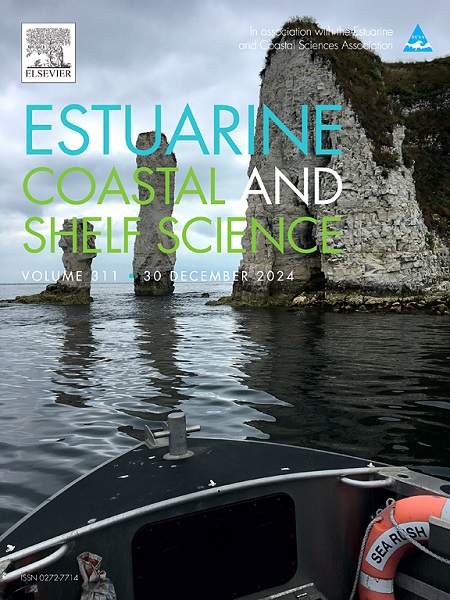初级生产者的功能冗余减轻了冰冲刷大叶藻草地的功能损失(Zostera marina, Linnaeus 1758)
IF 2.6
3区 地球科学
Q1 MARINE & FRESHWATER BIOLOGY
引用次数: 0
摘要
在北方和亚北极地区,海冰冲刷增加了浅海沿岸生态系统的底栖生物异质性。冰足可以困住大叶藻(Zostera marina)的叶子和沉积物,当它破裂时,一块块的植被要么被取代,要么被破坏,形成一个由植被和裸露的沉积物栖息地组成的马赛克。这种空间异质性反映了生物多样性和生态系统功能(BEF)关系可能分化的环境差异。本研究旨在探讨Rimouski湾北寒带冰蚀大叶藻草甸生物多样性与功能之间的关系。在为期20天的实验中,我们评估了从草甸采样的9个裸露沉积物和9个植被岩心中大型底栖生物群落多样性和生态系统功能的变化(基于碳、氧和养分通量)。我们假设裸露沉积物的物种密度、丰富度和群落功能比植被栖息地要低。事实上,基础物种Z. marina的缺失导致了大型动物群落的多样性降低,而在两个栖息地中都很丰富。在浸水过程中,试验开始时草心的净群落产量和呼吸量是试验开始时的5倍。然而,在整个试验过程中,由于绿藻(Ulva)的自然招募及其在初级生产中的功能冗余,这一差距减小了两个。然而,Ulva的非多年生性质对全年的功能冗余性提出了质疑,表明需要将生物多样性的季节性波动和功能评估结合起来,为BEF理论提供信息。本文章由计算机程序翻译,如有差异,请以英文原文为准。
Functional redundancy of primary producers mitigates function loss in an ice-scoured eelgrass meadow (Zostera marina, Linnaeus 1758)
In boreal and subarctic regions, sea ice scouring increases benthic heterogeneity of shallow coastal ecosystems. The ice foot can trap eelgrass (Zostera marina) leaves and sediments, and, as it breaks, patches of vegetation are either displaced or destroyed, creating a mosaic of vegetated and bare sediment habitats. This spatial heterogeneity reflects on environmental differences where biodiversity and ecosystem functioning (BEF) relationships can diverge. This study aims to explore the relationships between biodiversity and functioning in the boreal ice-scoured eelgrass meadow of Rimouski Bay (Québec, Canada). We assessed changes in diversity of the macrobenthic community and ecosystem functioning (based on carbon, oxygen, and nutrient fluxes) in 9 bare sediment and 9 vegetated cores sampled from the meadow, over a 20-day experiment. We hypothesized that bare sediment would exhibit lower species density, richness, and community functioning than vegetated habitats. Indeed, the absence of the foundation species Z. marina resulted in a less diverse macrofaunal community, as abundant in both habitats tough. During immersion, net community production and respiration were five-times higher in vegetated cores at the beginning of the experiment. However, this gap decreased by two throughout the experiment due to the natural recruitment of green algae (Ulva) and its functional redundancy in primary production. However, the non-perennial nature of Ulva questions functional redundancy all year long continuity, showing the need to integrate seasonal fluctuations in biodiversity and functioning assessment informing BEF theory.
求助全文
通过发布文献求助,成功后即可免费获取论文全文。
去求助
来源期刊
CiteScore
5.60
自引率
7.10%
发文量
374
审稿时长
9 months
期刊介绍:
Estuarine, Coastal and Shelf Science is an international multidisciplinary journal devoted to the analysis of saline water phenomena ranging from the outer edge of the continental shelf to the upper limits of the tidal zone. The journal provides a unique forum, unifying the multidisciplinary approaches to the study of the oceanography of estuaries, coastal zones, and continental shelf seas. It features original research papers, review papers and short communications treating such disciplines as zoology, botany, geology, sedimentology, physical oceanography.

 求助内容:
求助内容: 应助结果提醒方式:
应助结果提醒方式:


